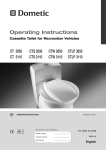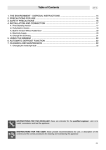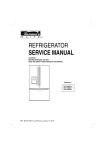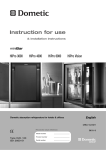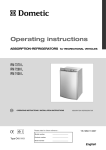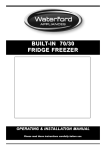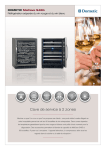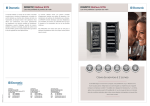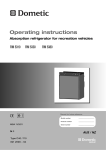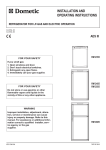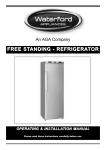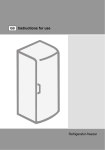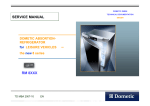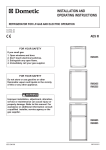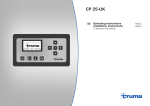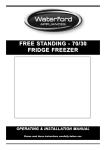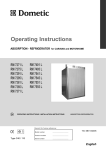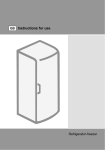Download INSTRUCTIONS FOR USE - Pdfstream.manualsonline.com
Transcript
INSTRUCTIONS FOR USE INSTALLATION INSTRUCTIONS DOMETIC - ABSORBER - REFRIGERATOR RGE 2000 Please state for future reference : DE EN FR IT Typ C40 / 110 822 6100-53 Deutsch English Français Italiano Model number ............................................. Product number ............................................. Serial number ............................................. GEBRAUCHSANWEISUNG USER MANUAL MODE D’EMPLOI ISTRUZIONI PER L’USO AUFSTELLANWEISUNG INSTALLATION INSTALLATION INSTALLAZIONE via INTERNET www.dometic.com Kundeservice Kundendienst Εξυπηρέτηση Πελατών Customer Service Servicio de Atención al Cliente Service après-vente Servizio Clienti Klantenservice Kundeservice Serviço de Atendimento a Clientes Asiakaspalvelu Kundservice Safety instructions Instructions for storing food in a refrigerator: No refrigerator of any kind can improve the quality of the food; refrigerators can only maintain the food's quality for a short duration as from the time of storing it. Please observe the following particular conditions for storing food in a refrigerator : - A change in the climatic conditions such as temperature fluctuations - High temperatures inside the room when it is closed and standing in direct sunlight - A refrigerator built in behind a window and exposed to direct sunlight - Storing the goods too soon, i.e. shortly after switching the device on for use Under these particular conditions the refrigerator cannot guarantee having the temperature needed for food that perishes quickly. Foods that perish quickly include: all the products with a stipulated use-by date and a minimum storage temperature of +4°C or less, especially for meat, poultry, fish, sausage, pre-packed foods. Instructions - Pack raw and cooked foods separately (e.g. in containers, aluminium foil, etc.) - Only remove the outside packaging of single packs if all the necessary data, such as the use-by date, for example, can also be read on the single packs. - Do not leave cooled goods outside the refrigerator for too long. - Place the foods with the next use-by date at the front, accordingly. - Pack away any left-over food again and eat at the first opportunity. - Wash your hands before and after touching any food. - Clean the inside of the refrigerator at regular intervals. Information : Please observe the instructions and information regarding the use-by date on the outside packaging of the food. Please observe the following sections in these instructions: "5.2 Cleaning" and "6.2 Storing food". These operating instructions should be kept in a safe place. If this device is passed on, please include these operating instructions with it. © Dometic GmbH - 2005 - Subject to change without notice - Printed in Germany 2 INHALTSVERZEICHNIS Information 1.0 INTRODUCTION 4 2.0 FOR YOUR SAFETY 4 2.1 2.2 Warning and safety notices Coolant 4 4 WARRANTY AND CUSTOMER SERVICE 5 3.1 5 3.0 4.0 5.0 DESCRIPTION OF MODEL 5 4.1 4.2 4.3 5 5 6 Model Technical Data Declaration of conformity INSTALLING THE REFRIGERATOR 6 5.1 5.2 6.0 Damages in transit Mounting and connecting Cleaning 6 8 OPERATING THE REFRIGERATOR 9 6.1 6.2 6.3 6.4 6.5 6.6 6.7 6.8 6.9 6.10 6.11 6.12 6.13 6.14 6.15 6.16 6.17 Switching on Storing food Making ice cubes Defrostin Positioning the storage racks Switching off Changing the doorhang Changing the decor panel Assembling the door grip Spare parts Accessories Troubleshooting Maintenance Product liability Product liability Disposal Energy-saving tips Umwelthinweis Achtung 3 9 11 11 12 12 12 13 14 14 14 15 15 16 16 16 16 16 Warnung 1.0 INTRODUCTION You have made an excellent choice in selecting the Dometic Absorption Refrigerator. We are sure that you will be fully satisfied with your new appliance in all respects. The appliance, which works silently, meets high quality standards and guarantees the efficient utilisation of resources and energy throughout its entire life cycle, during manufacture, in use and when being disposed of. Before you start to use the appliance, please read the installation and operating instructions carefully. The refrigerator is intended for installation in homes, cottages, hunting lodges or similar. The appliance has been certified for this application in accordance with EU Gas Directive 90/396/EEC. It is not designd for installation in leisure vehicles such as caravans or motorcaravans or boats. 2.0 FOR YOUR SAFETY Warning and safety notices 2.1 DANGER ATTENTION Never use a naked flame to check the appliance for leaks. Protect children! When disposing of the refrigerator, remove all refrigerator doors and leave the storage rack in the refrigerator. This will prevent accidental locking in or suffocation. If you smell gas: - close the locking tap of the gas supply and the valve on the cylinder. - open the windows and leave the room. - do not switch on anything electrical. - extinguish naked flames. Never open the cooling unit; it is under high pressure. Work on the gas and electrical components must only be carried out by qualified service personnel. It is imperative that the operating pressure should correspond to the data given on the model plate of the appliance. Compare the operating pressure data given on the model plate with the data on the pressure monitor of the liquid gas cylinder. Covers ensure electrical safety and must only be removed using a tool. The appliance must not be exposed to rain. The refrigerator is not suitable for the proper storage of medications. 2.2 Coolant Ammonia is used as a coolant. This is a natural compound also used in household cleaning agents (1 litre of Salmiak cleaner contains up to 200g of ammonia - about twice as much as is used in the refrigerator). Sodium chromate is used for corrosion protection (1.8% of the solvent). In the event of leakage (easily identifiable from the unpleasant odour): Switch off the appliance. Air the room thoroughly. Inform the authorised Customer Service department. 4 3.0 WARRANTY AND CUSTOMER SERVICE Warranty arrangements are in accordance with EC Directive 44/1999/CE and the normal conditions applicable for the country concerned. For warranty or other servicing, please contact our Dometic Service department. Any damage due to improper use is not covered by the warranty. The warranty does not cover any modifications to the appliance or the use of non-original Dometic parts; the warranty does not apply if the installation and operating instructions are not adhered to and no liability shall be entertained. Parts can be ordered throughout Europe from our Dometic Service department. Your Service Centre contact numbers are found in the “European Service Network” booklet. When contacting Dometic Service, please state the model, product number and serial number together with the MLC Code, if applicable. You will find this information on the data plate inside the refrigerator. 3.1 Damage in transit After removing the packaging, check whether the refrigerator has been damaged during transportation. Any damage sustained in transit must be reported to the trans portation company concerned no later than seven days after delivery of the goods. 4.0 DESCRIPTION OF MODEL 4.1 RGE 2000 Last digit 0 = manual ignition Model Refrigerator Gas / Electrical Absorption refrigerator operated with liquid gas and mains power 4.2 Technical Data Model Dimensions H x W x D (mm) depth incl. door RGE 2000 859 x 531 x 558 Groos capacity incl. freezer compartment 97 lit. Usable capacity of freezer compartment 10,5 lit. Connection Mains ~ 135 W * Consumption electricity / gas in 24 hrs Netweight Ignition Piezo ca.2,6 KWh / 270 g 32,2 kg X We reserve the right to make technical changes. *Average consumption measured at an average ambient temperature of 25°C in pursuance of ISO Standard. 5 4.3 5.0 5.1 Declaration of conformity INSTALLATION OF THE REFRIGERATOR Mounting and connection This fridge is tested and approved for usage in closed rooms. Mounting the fridge, please note the following points: The room must have a cubic capacity of at least 20m³, has to be well ventilated and have a window, which can be opened or a door, leading outside. The fridge has to be mounted free-standing, meaning a minimum space to surrounding walls or furniture of 50mm (no build-in!) The space between the fridge and objects (cupboards etc.) has to be at least 100mm. The fridge has to be mounted horizontally and on a steady subsurface. The fridge must not be exposed to heat radiation of hot objects (e.g. oven, radiator) The cooling unit on the backside (covered) has to be well-ventilated continuously. Do not cover the cooling unit (e.g. towels, curtains). Not sufficient ventilation will lead to loss of cooling performance! The fridge must be protected from spray water. Please respect, that the fridge is not exposed to rain, before or during the mounting. 6 5.1.1 Placing the gas bottle 5.1.2 Gas bottles have to stand up straight. Place the gas bottle well-ventilated. Place the gas-bottle, where it can be easily recognized in case of a fire. The distance between the gas bottle and the fridge must not exceed 1,5m. Only use bottle types and pressure regulation device that are valid in the particular country. Electrical connection The power must be supplied via a properly earthed socket outlet. It is advisable to run the incoming supply through an automatic circuit breaker. The supply voltage must correspond to the value specified on the data plate. Any difference in values may result in damage the appliance. The power cable must be laid in such a way that it does not come in contact with hot components of the unit/burner or with sharp edges. If the connection cable is damaged it must be replaced by the Customer Service at Dometic, or by respectively qualified personnel, in order to prevent any hazards. 5.1.3 Gas connection The refrigerator should only be operated using liquid gas (propane, butane). Do not use town gas or natural gas. The correct connection of the fridge has to be carried out by a skilled specialist. Note the particularly valid national rules for usage of LG-driven appliances. Technical Standards EN 732 A preset pressure regulator A has to be installed within the supplying line to the fridge. The fridge must not be operated with any other pressure than the one indicated on the rating label. The fridge has to be connected to the gas bottle with a security hose pipe. Choose a sufficient length to connect the hose pipe without kinks. The hose must not be longer than 1.5 m. The gas connection to the appliance is effected by means of a suitable coupling tube fitting L8, DIN 2353-ST, complying with EN 1949 (e. g. Ermeto). bottle valve A Source: Fa. GOK, Marktbreit A SW 14 SW 17 7 The hose has to be replaced within the intervals settled in the particular national rules. After having connected the gas bottle, a leak test at all joints and a burner flame test have to be carried out. Use a leak indicating spray or a foaming agent carrying out the leak test. After having opened the bottle valve check the joints for bubbles. Never use a naked flame to check the appliance for leaks. 5.1.4 Categories of appliances Table of gas pressure Category I3P(30) mbar 30 I I3+ I3P(50) 3P(37) 37 50 BE 28-37 30-37 I3B/P(50) I3B/P(30) 50 30 X DK X DE X FI FR X GR X IE X X X IS X IT X LU X X NL X X NO X AT X PT X X X SE X CH X ES X UK 5.2 X X X X X X Cleaning Before switching the refrigerator on to use it, we recommend that you clean it inside and out, and repeat this at regular intervals. Use a soft cloth and lukewarm water with a mild detergent. Then rinse the appliance with clean water and dry thoroughly. Remove dust from the refrigerator unit at yearly intervals using a brush or soft cloth. ATTENTION To avoid deterioration of materials: Do not use soap or hard, abrasive or soda-based cleaning agents. Do not allow the door seal to come into contact with oil or grease. 8 6.0 6.1 OPERATING THE REFRIGERATOR Putting in operation The cooling unit is silent in operation. When the appliance is first put into operation, there may be a mild odour which will disappear after a few hours. Ensure the living area is well ventilated. The refrigerator will take several hours to reach its operating temperature in the cooling compartment. The freezer compartment should be cold about one hour after switching on the refrigerator. 6.1.1 Controls Energy selection and temperature setting, “Piezo” igniter A A B C D = = = = C B D energy selection switch gas/electric thermostat push button “manual ignition (Piezo-igniter)” flame indicator display (galvanometer) Note: The refrigerator is equipped to operate on mains power or liquid gas (propane/butane). The desired power option is selected by means of energy selector switch (A). Energy selector switch (A) has four settings: O (off1), 230V (mains power, AC) , O (off2), Gas (liquid gas) Off AC, mains power Off Gas 9 6.1.2 Electrical operation AC 230V~ This option should only be selected where the supply voltage of the connection for power supply corresponds to the value specified on the data plate. Any difference in values may result in damage the appliance. 1. Set energy selector switch (A) to 230V . A 6.1.3 2. Use rotary switch (B) to regulate the temperature in the main refrigerator compartment. B Gas operation The refrigerator should only be operated using liquid gas (propane, butane). Do not use town gas or natural gas. Manual ignition (Piezo-igniter) 1. Open the valve of the gas cylinder 2. Set energy selector switch (A) to gas. 3. Press and hold (B) rotary switch. B A C 6. 7. 8. 9. 4. Activate Piezo ignition (C) several times at intervals 1 second. 5. The needle reaches the green range if the flame is ignited Keep rotary switch (B) depressed for another 10-15 seconds, then release. Check the galvanometer to see whether the flame is burning. Repeat the entire process if the flame has been extinguished. Use rotary switch (B) to regulate the temperature in the main refrigerator compartment. All gas operated refrigerators are equipped with an automatic flame protection, which automatically cuts off the supply of gas approximately 30 seconds after the flame has been extinguished. When using for the first time, and after changing the gas cylinder, the gas pipes may contain air. By means of brief operation of the refrigerator and any other gas appliances (e.g. cookers), air is removed from the gas pipes. The gas will then ignite without delay. 10 6.1.4 Temperature setting cooling compartment B As shown, you are able to regulate the temperature of the cooling compartment, if necessary, by turning rotary knob (B) . Medium setting The cooling unit’s performance is influenced by ambient temperatures. Please select the medium setting for ambient temperatures between +15°C TIP and +25°C. The unit operates within its optimum performance range. Dometic refrigerators work according to the absorption principle. Due to physical reasons, an absorption system responds slowly to changes made on the thermostat controller, or a loss in cooling through opening the door, or storing food. The devices fulfill the cooling performance requirements of the Climatic Class SN acc. to EN/ISO 7371 in the temperature range of +10°C to 32°C ambient temperature. 6.2 Storing food Switch the refrigerator on approx. 12 hours before filling it. Always store pre-cooled foods in the refrigerator. Make sure that the food is well cooled when it is bought and also when transporting it. Use insulated cooling bags. When taking food out of the refrigerator only open the refrigerator door very briefly. Foods must be packed - best of all in closed containers - and stored separately from each other. Allow foods that have been warmed up to cool down before storing. Store quickly perishable foods directly next to the cooling fins. The air around the cooling MUST be able to circulate freely without any hindrance. Products that could emit volatile, flammable gases must not be stored in the refrigerator. The freezer compartment is suitable for making ice cubes and for short-term storage of frozen food. It is not suitable as a means of freezing foods. 6.3 Making ice cubes Ice cubes are best frozen overnight. At night, the refrigerator has less work to do and the unit has more reserves. 1. Fill the ice cube tray with drinking water 2. Place the ice cube tray in the freezer compartment. Only use drinking water! 11 6.4 Defrosting As time goes by, frost builds up on the fins. When the layer of frost is about 3mm thick, the refrigerator should be defrosted. 1. Switch off the refrigerator, as described in section “6.6 - Switching off". 2. Remove the ice cube tray and food. 3. Leave the refrigerator door open. 4. After defrosting (freezer compartment and fins free of frost), wipe the cabinet dry with a cloth. 5. Use a cloth to mop up the water from the freezer compartment. 6. Switch the refrigerator back on again. The layer of ice must never be removed forcibly, nor may defrosting be accelerated using a heat source. Note: Water thawing in the main compartment of the refrigerator runs into an appropriate container at the back of the refrigerator. From there, the water evaporates. 6.5 Positioning the storage rack Dismantling: 1. 1. Loosen the front and back securing brackets. 2. 2. Move the storage rack to the left and remove it. To fit the storage rack, the reverse order applies. 6.6 Switching off 2. Leave the door open. It shall be slightly ajar. This is to prevent mould from forming inside the appliance. A 1. Set energy selector switch (A) to position "0" (OFF). The appliance is now fully switched off. Switching off gas operation If the refrigerator is to be taken out of service for an extended period of time, the on-board shut-off valve and the cylinder valve must be closed. 12 6.7 Changing the doorhang 1. Open the door, unscrew the hinge screw and keep it to hand. 2. Take off the door by moving it in your direction. 4. 3. 2. If it is necessary to tilt or lay the fridge onto the side, wait for one hour, before taking the fridge into operation. The cooling agent runs back into the reservoir of the cooling unit. Thus a correct operating of the fridge is guaranteed. 1. 5. 6. 3. 4. Loosen hinge pin..... ... and screw it in at opposite side. 5. 6. Transfer distance washer on lower hinge. 7. Shove door into upper hinge pin and put it on lower hinge. 8. Screw in hinge screw. Check that the door moves freely and the gasket seals completely when the door ic closed. 13 6.8 Changing the decor panel 1. Disassemble the door, as described in "6.7" 2. Unscrew the door strip (3 screws). 3. Remove the decor plate and insert a new decor plate 4. Screw the door strip back in position. 5. Put in door, as described above. Dimensions of the panels in mm: Model RGE 2000 6.9 Hight 718+/-1 Thickness 3,2 Assembling the doorgrip 1. The fixing points are marked on both sides. 6.10 Width 491,5+1 2. Adjust door handle at the door and screw onto it. 3. Attach cover and fix by pushing. Spare parts Parts can be ordered from the Dometic Customer Service. When contacting Dometic Service, please state the model, product number and serial number together with the MLC Code, if applicable. You will find this information on the data plate inside the refrigerator. 14 6.11 Accessories Activated carbon filter (prevents odours) Order number : 958 046 002 Egg shelf Order number : 958 046 010 6.12 Troubleshooting Before calling the authorised Service Department, please check whether: 1. The instructions in the section "Using the refrigerator" have been followed. 2. The refrigerator is not tilted excessiveley. 3. It is possible to operate the refrigerator with an available power source. The refrigerator does not work in gas operation mode.. Possible cause Action you can take a.) Gas bottle empty. a.) Change gas bottle. b.) Is the supply cut-out device open? b.) Open the cut-out device. c.) Air in the gas pipe? c.) Switch device off and on again 3-4 times to remove air from the gas pipe. The refrigerator does not work on 230V. Possible cause Action you can take a.) Fit new fuse. a.) Fuse defective. The refrigerator does not cool sufficiently. Possible cause Action you can take a.) Inadequate ventilation to the unit. a.) Check that the ventilation grille of the cooling unite is not covered. b.) The thermostat setting is too low. b.) Turn the thermostat to a higher setting. c.) There is too much ice on the condenser. c.) Check that the refrigerator door seals when shut. d.) Too much warm food put inside. d.) Let food cool down first. e.) Appliance running for a short time. e.) Wait several hours, check again. 15 6.13 Maintenance Works on gas components and electrical installation may only be carried out by authorised personnel. We recommend to contact your Dometic Service Centre. It is recommended that the gas burner be inspected and cleaned as necessary at least once a year. TIP We recommend maintenance following an extended shutdown. 6.14 Product liability Product liability of Dometic GmbH does not include damages which may arise from faulty operation, improper alterations or intervention in the equipment, adverse effects from the environment such as changes in temperature and air humidity, which may impact the equipment itself or the direct vicinity of the equipment or persons in the area. 6.15 Environmental hints Refrigerators manufactured by Dometic GmbH are free of CFC/HCFC and HFC. Ammonia (a natural compound of hydrogen and nitrogen) is used in the cooling unit as a coolant. The non-ozone-hazardous cyclopentan is used as a propellant in the manufacture of the PU foam insulation. 6.16 Disposal In order to ensure that the recyclable packaging materials are re-used, these should be sent to the usual local collection system. The appliance should be transferred to a suitable waste disposal company that will ensure re-use of the recyclable components and proper disposal of the rest. For eco-friendly draining of the coolant from all absorber refrigeration units, a suitable disposal plant should be used. Appliances bearing this symbol must be deposited at the designated local reception point for the disposal of electrical and electronic equipment. It is not permitted that this product be disposed of by way of the normal 6.17 household refuse collection system. Dometic refrigerators bear this symbol on the data plate to be found in the interior of the unit. Energy-saving tips At an average ambient temperature of approx. 25°C, it is sufficient to operate the refrigerator at the middle thermostat setting (for both gas and mains voltage). Where possible, always store goods that have previously been cooled. Do not position the refrigerator in direct sunlight. Constant circulation of air must be supplied to the refrigerator unit. Defrost regularly. Open the door only for a short time when removing goods from the refrigerator. Run the refrigerator for about 12 hours before filling it. 16 Notices 17 Dometic GmbH In der Steinwiese 16 D-57074 Siegen www.dometic.de/caravan www.dometic.com


















